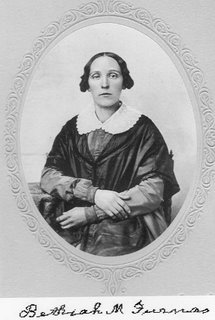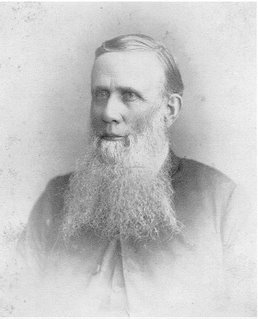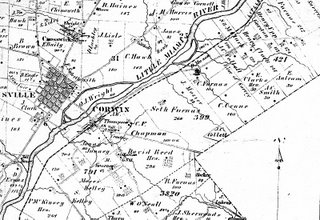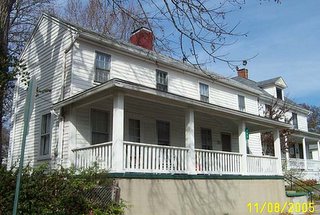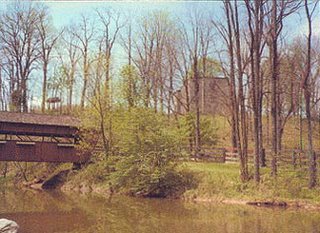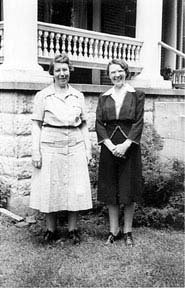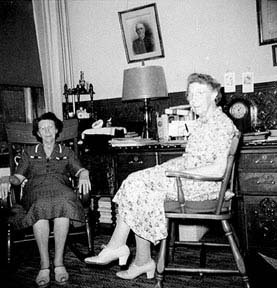Charity Lynch ~ A Life of Struggles and Triumph (1779 ~ 1848)

The Charity Lynch House ~
Waynesville, Ohio
(Later known as the May Wright ~ Mary Current House)
See another view of the house below.
The following is the obituary of Charity Hasket Lynch, published in the Quaker periodical, "The Western Friend", dated March 1848. "The Western Friend" was published by Achilles Henry Pugh in Cincinnati.
"DIED ~~ On the 11th day of March, 1848, in Hamilton, Ohio, CHARITY LYNCH, in the sixty-ninth year of her age. During her life time, the deceased was a member of the Society of Friends, and though for many years, in the latter part of her life, she was deprived, in a great measure of enjoying the privileges of their meetings, yet her attachment to the Society, and the principles of the Society, did not in any degree abate. In her last illness of twelve days, she often spoke of her love for the Friends; she said, 'I love their voice, I love their silence, I love their spiritual worship.' When deprived of the meetings of her own Society, she sought and enjoyed Christian communion and fellowship and religious conversation with the pious of other denominations. The graces of meekness, humility and benevolence, was exemplified by her through all her Christian course. Her delight was in the law of the Lord; she searched the Scriptures and found by a happy experience, that their testimony is able to make one wise unto salvation by faith in Christ Jesus. Although useful to society, to the community in which she lived, and especially to her children, yet it pleased God in wisdom, to lay his afflicting hand upon her; but through all her sickness, she manifested a calmness and peace of mind which religion alone can give. Her peace was as a river, her joy as the waves of the sea. Though her bed was the bed of death, it was the spot around which ministering angels stood ~ though her room was the room of dying groans, yet it was made joyful to her by the presence of her God. ~~ Her heavenly Shepherd accompanied her through the vale of death ~ she feared no ill ~ resting her sinking head upon the bosom of her Savior, she 'breathed her life out sweetly there.' On Sabbath afternoon, the 12th inst., her body was committed to the silent tomb, attended by a large concourse of friends and acquaintances, who testified their respect for her worth, by mingling their tears with those of her children and grandchildren who followed her remains to the 'narrow house appointed for all the living.' Her countenance, when cold in death, radiated a sweet, a heavenly smile.
'Calm on the bosom of thy God,
Sweet spirit rest thee now!
E'en while with us they footsteps trod,
His seal was on thy brow.
Dust to its narrow house beneath!
Soul to its place on high!
They that have seen thy face in death,
No more may fear to die.'
A tribute to the memory of a beloved mother, by an affectionate son.
T. H. L." (Thomas Hasket Lynch)
~~~~~~~~~~~~~~~~~~~~~~~~~~~~~~~~~~~~
Charity Hasket (b. October 27, 1779 in the Bush River Valley of South Carolina ~ d. March 11, 1848 in Hamilton, Butler Co., Ohio) was a daughter of Isaac and Lydia Elliott Hasket. She married Isaiah Lynch at Bush River on March 20, 1801. Isaiah Lynch (b. April 1, 1768 near the Saluda River in South Carolina ~ d. July 27, 1814 in Waynesville, Warren Co., Ohio) was the son of David and Esther Embry Lynch.
Charity Hasket Lynch and her young husband, Isaiah Lynch, moved from Bush River Monthly Meeting of Friends in South Carolina to Waynesville, Ohio in 1805. Like many Friends in the south, they left and settled in Ohio to escape the institution of slavery. They had three little girls with them all under the age of five: Sarah Ann, Rebecca, and Rachel. The first Lynch home was located on Main Street in Wabash Square (between High and Miami Streets)near the local tavern and stagecoach stop. While living in this residence, five more children were born: Mary, Thomas Hasket, Elijah, Isaac and William Mercer.
They decided to move away from the area of the tavern to a healthier part of the village. They bought a three and a half acre lot near the White Brick Meetinghouse of the Miami Monthly Meeting of the Society of Friends on top of "Quaker Hill". The land had been previously owned by Friend David Faulkner (January 1807) and Friends Roland and Lydia Richards (June 1807). They engaged David Jones, a friend of theirs, to construct the new house. Just as the house was being finished, Isaiah Lynch came down with typhoid fever and this father at the age of 45 died on July 27, 1814. He is buried, as is his youngest son William Mercer, who died in 1813, in the Friends graveyard in Waynesville.
Charity was prostrate with grief and she was probably ill with the same sickness that had just killed her husband. The members of the Quaker meeting in Waynesville were convinced that she would not survive her illness since she was so frail. They would have seven orphan children to care for. It was decided to parcel them out to be raised in Quaker families:
- Twelve year old Sarah, the oldest, went to live with Dr. and Mrs. Joseph Canby of Lebanon, Ohio
- Rebecca and Isaac went to live with an elderly couple Seth and Elizabeth Smith who lived near Green Plain Monthly Meeting outside of Selma, Ohio.
- Rachel, Mary and Thomas were taken to homes in Cincinnati.
- Elijah went to live with David and Polly Littler near Waynesville
To everyone's surprise, with the help of Dr. Lathrope of Waynesville, she rebounded. However, to add to Charity's grief as she recovered from her illness, news arrived from Cincinnati that her little Mary had died in late November of 1814 and had been buried in a Potter's Field.
The new family home would need to be sold and what funds were left would be used to re-unite the dispersed family. On November 19, 1816 Friend Noah Haines bought the property at a Sheriff's auction.
Charity moved to Cincinnati where she rented a house, which she then ran as a boarding house. Thomas and Rachel were reunited with their mother in Cincinnati. A devoted Quaker, Charity and her children attended Cincinnati Monthly Meeting of Friends which had just been founded. She was never able to find the exact spot of her daughter's burial.
After a few years in Cincinnati, Charity and the children moved to Springboro, Ohio. She was friend of Jonathan and Mary Wright who encouraged her to move to their village. So in June of 1818 Charity bought a lot in Springboro and while a new brick house was being built, she rented a small house to live in with her children. Rachel and Thomas were joined by Sarah and Elijah. Charity traveled to Green Plain and brought home, Rebecca and Isaac. The family lived in Springboro up until 1826 when Charity moved to Hamilton.
The rest of her story and the story of her devoted children can be found in Alta Harvey Heiser's book, Quaker Lady: The Story of Charity Lynch and Her People (Oxford, Ohio: The Mississippi Valley Press, 1941).
Waynesville lore states that the Charity Lynch House is haunted by Charity who is looking for her little girl, Mary, who died in Cincinnati when she was separated from her ill mother.
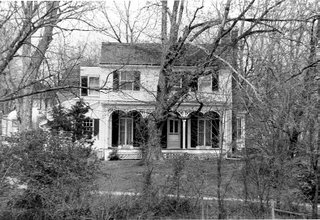
View taken from the backyard of the
The 1905 Friends Boarding Home ~ Waynesville, Ohio
